How can the printing industry play its part in reducing the overall carbon footprint of the packaging supply chain? It’s one of the questions that must be addressed as we grapple with the global climate crisis and move – hopefully – towards a more sustainable future.
For Toray Industries, Inc., one of the answers lies in offset Electron Beam (EB) technology. Victoria Hattersley spoke with Itsue Yanagida, Business Development Manager, Graphic Systems, Toray International Europe GmbH.
What is the most efficient, most sustainable solution for the future of packaging print? According to Toray, the answer lies in electron beam (EB) offset technology.
When it comes to the flexible packaging industry, offset technology is still not as widely used as the more ‘traditional’ print techniques such as gravure and flexographic. However, this may change: according to Itsue Yanagida, “Offset printing is more competitive especially in short and medium runs as it has a shorter time to market and offers more flexibility for production, as offset plate can be imaged within minutes. Also, offset printing plate material and processing costs are much lower than ‘traditional’ printing plates and cylinders. Recently these advantages of offset printing have been getting more important as food and consumable products are shifting to a wider variety of goods in smaller quantities.”
In Europe, Toray may perhaps be known primarily as a chemicals manufacturer, but in fact the company has also been active in the printing industry for over 50 years, when it initiated its first R&D projects in the field. In addition to the European headquarters in Neu-Isenburg near Frankfurt, Toray offers its solutions for the packaging industry at two other European locations: Toray Textile Central Europe (TTCE) produces and distributes the company’s IMPRIMATM FR printing plates while also carrying out R&D; and Toray Films Europe (TFE) is focused on the production of special films.

THE MOST SUSTAINABLE CHOICE?
Why exactly does Toray believe EB offset is the most environmentally sustainable solution? Itsue Yanagida says there are two main reasons for this.
“First, the volume of solvent used in gravure and flexo is high, leading to high CO2 emissions. On the other hand, EB offset ink doesn’t include any solvent so that it automatically results in lower CO2 emissions. Second, solvent ink need more energy to vaporize solvents from the inks and oxidize solvents from the hot air. Furthermore, as offset plates are made of aluminum, they can be recycled whereas flexo plates cannot. In the end, the total energy consumption of an EB offset press such as Comexi’s Offset CI Evolution is much less than in other ‘traditional’ printing technologies.”
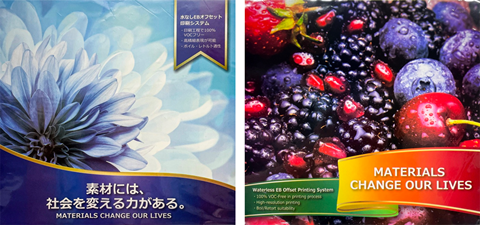
According to Comexi, with whom Toray has formed a strong working partnership, its central impression cylinder (CI) offset printing technology, using EB curing inks, is solvent-free and is able to reduce the number of substrate layers and the carbon footprint. It encompasses, says the company, the advantages of offset printing and the safety of low migration EB inks and coatings, resulting in a wide range of substrates to be used for many applications.
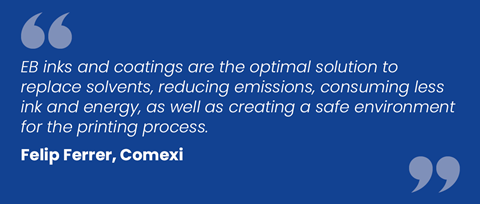
“EB inks and coatings are the optimal solution to replace solvents, reducing emissions, consuming less ink and energy, as well as creating a safe environment for the printing process,” says Felip Ferrer, Business Development Manager, Offset printing, when asked to elaborate further on the benefits of this technology for the industry. “They are also highly resistant to chemicals, heat, sealing, and scratching, thus providing genuine replacement solutions, which are more recyclable and efficient than complex laminations. This is achieved by reducing the number of layers. When choosing to print PE reverse, the partial crosslink process will increase the thermal resistance of the external packaging layer, while surface printing results in the EB coating providing high surface protection.”
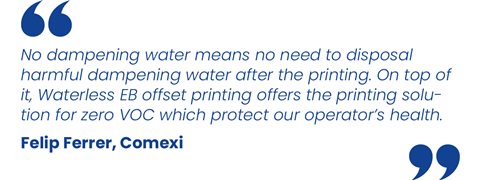
Then there are the VOCs (volatile organic compounds) to consider: to give a brief overview for the uninitiated, VOCs include a range of gases and small particles released during the manufacture of certain products. When it comes to the flexible packaging industry, this generally happens during the printing process itself. We now know that the particulates emitted have a major impact on the environment, contributing to the ‘greenhouse effect’ and emitting high levels of CO2. They are also highly detrimental to human health, particularly that of people with asthma, young children, the elderly and those who work in close proximity to these emissions. EB offset inks are entirely free of VOCs and are also an attractive alternative for flexible packaging printing.
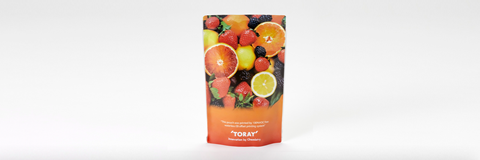
WHY WATERLESS?
“On top of the above advantages of offset EB printing, there is another reason Toray is also a strong proponent of waterless offset EB printing.” adds Itsue. “While conventional offset printing requires the use of dampening water which typically contains environmentally damaging isopropyl alcohol and the wastewater after printing has to be handled as harmful liquid, waterless offset printing includes a water-absorbent material to cover the areas with no image, while an ink-repellent layer is applied which eliminates the need to use water on the printing plates and contributes to expanding the coverage of applicable film substrates.”
“Toray also supplies materials that can be used to produce VOC-free, water-washable EB inks. These special inks are cured using EB and don’t involve any solvents, which typically contain VOC. This makes 100% VOC-free printing possible for the first time, protecting both the environment and workers’ health.”
Toray’s unique waterless solution is its IMPRIMATM FR printing plates, which it says ‘enable a revolutionary way to make printing more environmentally friendly’. Alongside the environmental benefits it is also designed to allow faster setup, easier control and better consistency. The result is improved printing quality compared to traditional wet offset with brighter, more vibrant colours at higher resolution thanks to a colour-fast silicone coating with a thin polymer layer underneath with the ability to print on non-absorbent substrates, such as films.
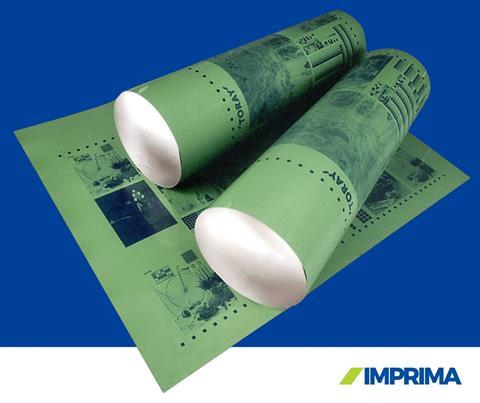
The technology has been successfully tested with a European company and is also suitable for use in retort and boil packaging. In the future, Toray hopes that this VOC-free system will become a ‘global standard’ in the field.
But as offset, especially waterless offset, is still a relatively new technology – at least for the flexible packaging industry – are there any drawbacks that will still need to be overcome?
“The main one is the challenge of transferring the original graphic designs into offset printing,” says Itsue. “In other words, the fact that printing qualities and outcomes vary between printing technologies means that sometimes customers can be reluctant to switch from more traditional methods to offset. Perhaps they feel that it will be a complex process, when in fact this is not the case. One way in which we at Toray can address this is to communicate the benefits of this technology and its high printing quality to customers through the many media channels and touchpoints we have available to us.”
FUTURE PROSPECTS FOR EB OFFSET
Given all the above, it will be very interesting to see what the future holds for EB offset technology in Europe in the coming years. In particular, what role can we expect it to play in reducing the overall carbon impact of packaging?
“Because diverse changes and improvements are being made in films,” says Itsue, “the waterless EB offset printing system has to adapt to these new substrates. It will be a process of continuous development until carbon neutrality and circularity realized. But again, we wish to stress the major advantages of waterless EB offset printing in terms of CO2 reduction and zero VOC.”
For Toray, the next frontier will be to offer VOC free waterless EB offset printing technology for monomaterials. This would ensure its compatibility with more recyclable packaging formats and, ultimately, help the industry move closer towards a circular economy.
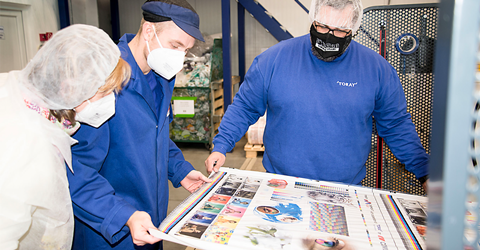
CHEMOSVIT FOLIE CASE STUDY: PARTNERING IN FLEXIBLE PACKAGING SOLUTIONS

Throughout its long history in print, Toray Industries, Inc. has developed many strong partnerships with a range of players across the flexible packaging industry. One such company is the Slovakia-based Chemosvit Group – a European supplier of flexible packaging solutions for the food (80%) and non-food (20%) segments.
The company works with a mix of printing technologies, one of which is EB offset – making it an ideal fit for the cooperation with Toray which began earlier this year. Through this, Chemosvit has been testing Toray’s EB waterless printing technology for different kinds of flexible materials.
“This is a really interesting idea for the development of easier and effective printing processes,” said Daniel Dudaško, Project Manager, Chemosvit Group. “We believe waterless EB offset printing could give us input into how to optimize/ change the film properties to achieve the best printing results. Through this cooperation, we are working on fine-tuning the new printing technology.”
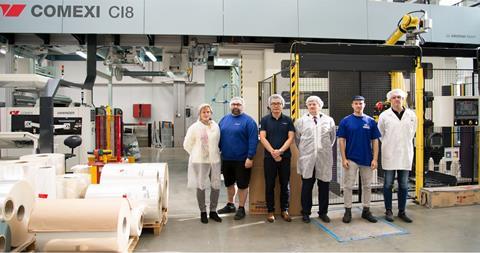
MEETING THE SUSTAINABILITY CHALLENGES
And more generally, how does Chemosvit view the sustainability challenges facing the industry and what are the most important issues that need to be addressed if we are to achieve a fully circular economy?
“The new mantra of the packaging industry for next few years will be sustainability and circularity. All producers must develop products which can be easily separated and recycled. There are many discussions on the use of PCR regranulates for food packaging; this is really interesting question, but the PCR regranulates can´t compare with virgin granulates. A second interesting idea for the circular economy is chemical recycling, which produces granulates with the same quality as virgin, but today the products from this process are more expensive the standard material.”
EB offset printing as a technology that is fully compatible with recyclable materials and as our Chemosvit spokesperson tells us, “We fully agree with circular economy ideals, and we also fully support the production and development of the materials which can be recycled.”

New for 2020, this premium feature brings a completely new way for you to interact with our audience through a combination of collaborative editorial and premium promotion. An article written together between you and Packaging Europe’s content team, The Wider View will have a dedicated widget across all web pages & eNewsletter, and will link to a stunning, long-format web page put together by our design team featuring your graphics and branding. Carrying no other advertising, and pushing the limits of ordinary web communications, this is the ultimate digital content package.






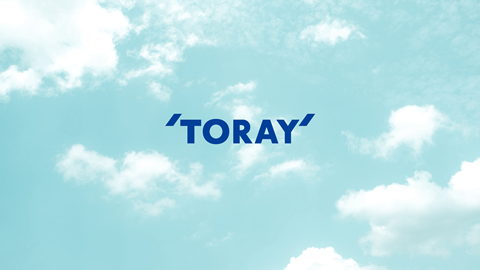
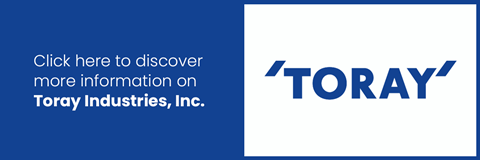






No comments yet